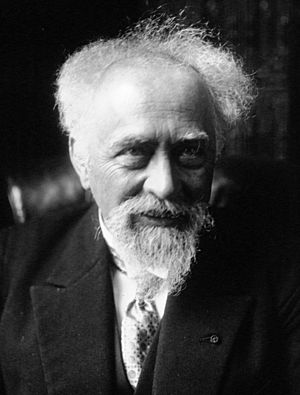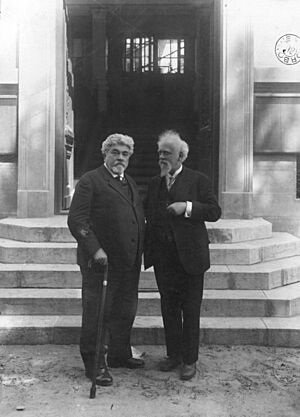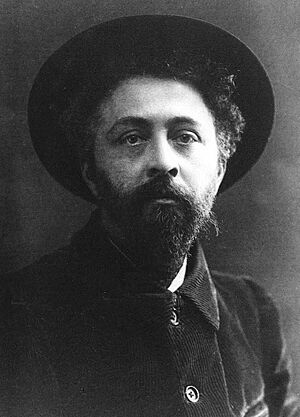Jean Baptiste Perrin facts for kids
Quick facts for kids
Jean Baptiste Perrin
|
|
|---|---|

Perrin in 1926
|
|
| Born | 30 September 1870 |
| Died | 17 April 1942 (aged 71) New York City, U.S.
|
| Nationality | French |
| Alma mater | École Normale Supérieure University of Paris |
| Known for | Nature of cathode rays Brownian motion Avogadro constant Sedimentation equilibrium Perrin friction factors |
| Awards | Matteucci Medal (1911) Fellow of the Royal Society (1918) Nobel Prize in Physics (1926) |
| Scientific career | |
| Fields | Physics |
| Institutions | École Normale Supérieure University of Paris |
| Signature | |
 |
|
Jean Baptiste Perrin ForMemRS (born September 30, 1870 – died April 17, 1942) was a French physicist. He studied how tiny particles move in liquids, a process called Brownian motion. His work helped prove Albert Einstein's ideas about this movement. This confirmed that everything around us is made of atoms. For this important discovery, he won the Nobel Prize in Physics in 1926.
Contents
Biography
Early Life and Education
Jean Baptiste Perrin was born in Lille, France. He went to a very good school in Paris called the École Normale Supérieure. From 1894 to 1897, he worked there as an assistant. During this time, he started studying cathode rays and X-rays.
In 1897, he became a lecturer in physical chemistry at the Sorbonne in Paris. He later became a full professor at the University in 1910. He held this job until Germany took over France during World War II.
Important Discoveries and Research

In 1895, Perrin showed that cathode rays carry a negative electric charge. He also found a way to figure out Avogadro's number. This number tells us how many particles are in a certain amount of a substance.
Perrin also suggested that the Sun gets its energy from thermonuclear reactions of hydrogen. This means that hydrogen atoms combine to form helium, releasing a lot of energy.
In 1905, Albert Einstein shared his ideas about Brownian motion. This is the jiggling movement of tiny particles in a fluid. Perrin then did experiments to test Einstein's ideas. His experiments proved Einstein was right. This helped settle a long debate about whether atoms really exist.
In 1926, Perrin won the Nobel Prize in Physics. He received it for his work on how matter is made of tiny, separate particles. This work finally proved that molecules are real.
Perrin wrote many books and papers about his scientific work. Some of his famous books include "Rayons cathodiques et rayons X" (Cathode Rays and X-rays) and "Les Atomes" (The Atoms).
Awards and Recognition
Perrin received many important awards. He won the Joule Prize from the Royal Society in 1896. He also received the La Caze Prize from the French Academy of Sciences. He was part of the Solvay Committee in Brussels twice, in 1911 and 1921.
He was also a member of many science academies around the world. These included the Royal Society of London and academies in Belgium, Sweden, and China. In 1926, he became a Commander of the Legion of Honour, a very high award in France.
Contributions to Science Organizations
In 1927, Perrin helped start the Institut de Biologie Physico-Chimique. This was a research center for physical chemistry and biology. In 1937, he created the Palais de la Découverte, a popular science museum in Paris.
Perrin is also seen as the founder of the National Centre for Scientific Research (Centre National de la Recherche Scientifique (CNRS)). This is France's main public research organization. He asked many scientists, including Nobel Prize winners, to sign a petition. Because of this, the French government created a national research council in 1933. Later, in 1939, these groups were combined to form the CNRS.
One of Perrin's famous students was Pierre Victor Auger. Jean Perrin's son, Francis Perrin, also became a physicist.
Later Life and Legacy
Perrin was an officer in the engineering army during World War I. He was also known for his political views as a socialist.
In 1938, Perrin's wife, Henriette, passed away. Later, Nine Choucroun, a scientist, became his partner. In June 1940, when Germany invaded France, Perrin and Choucroun escaped to Casablanca. They later traveled to New York City in December 1941.
Jean Perrin died in New York on April 17, 1942, when he was 71 years old. After World War II ended, his body was brought back to France in 1948. He was buried in the Panthéon, a famous building in Paris where many important French people are laid to rest.
Works
- Les Principes. Exposé de thermodynamique (1901)/Principles of thermodynamics
- Traité de chimie physique. Les principes (1903)/Physical chemistry principles
- Les Preuves de la réalité moléculaire (1911)/Evidences of molecular reality
- (in fr) Atomes. Paris: Alcan. 1913. https://gutenberg.beic.it/webclient/DeliveryManager?pid=6564725.
- Les Atomes (1913)/The Atoms
- Matière et lumière (1919)/Matter and light
- En l'honneur de Madame Pierre Curie et de la découverte du Radium (1922)/ In honor of Mrs Pierre Curie and the discovery of Radium
- Les Éléments de la physique (1929)/Elements of physics
- L'Orientation actuelle des sciences (1930)/Current orientation of sciences
- Les Formes chimiques de transition (1931)/Transition chemical forms
- La Recherche scientifique (1933)/Scientific research
- Cours de chimie. 1ère partie. Chimie générale et métalloïdes (1935)/ Chemistry courses: general chemistry and metalloids
- Grains de matière et grains de lumière (1935)/Grains of matter and grains of light
- Existence des grains/Existence of grains
- Structure des atomes/Structure of atoms
- Noyaux des atomes/Kernels of atoms
- Transmutations provoquées/Induced transmutations
- Paul Painlevé: l'homme (1936)/Paul Painlevé: the man
- L'Organisation de la recherche scientifique en France (1938)/The organisation of scientific research in France
- À la surface des choses (1940-1941)/At the surface of things
- Masse et gravitation (1940)/Mass and gravitation
- Lumière (1940)/Light
- Espace et temps (1940)/Space and time
- Forces et travail (1940)/Forces and work
- Relativité (1941)/Relativity
- Électricité (1941)/Electricity
- L'énergie (1941)/Energy
- Évolution (1941)/Evolution
- L'Âme de la France éternelle (1942)/The soul of eternal France
- Pour la Libération (1942)/For Liberation
- La Science et l'Espérance (1948)/Science and hope
- Oeuvres scientifiques de Jean Perrin (1950)/Scientific works of Jean Perrin
See also
 In Spanish: Jean Perrin para niños
In Spanish: Jean Perrin para niños


